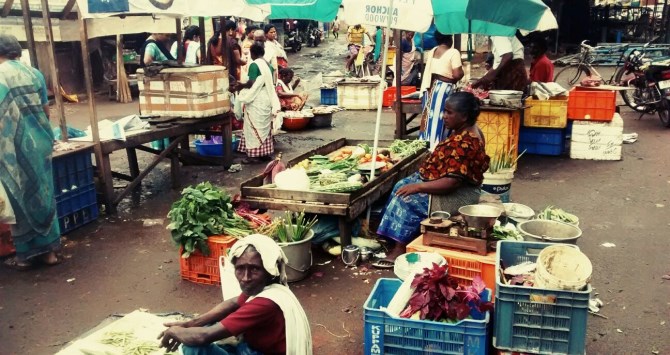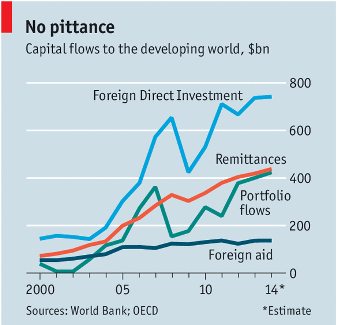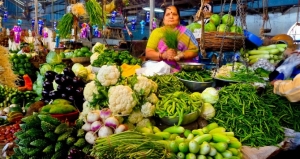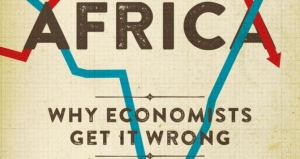
Reading the Economist cover to cover is an illicit pleasure – it may be irritatingly smug and right wing, especially on anything about economic policy, but its coverage on international issues consistently goes way beyond standard news outlets.
This week’s edition had everything from the changing face of Indian marriage to the spread of pedestrian and cycling schemes around the world to (for science geeks) the intriguing question of why time is irreversible.
But the standout piece was on the impact of migration and remittances on Kerala, in South India:
‘Last year India received $70 billion in remittances – more than any other country in the world. The state of Kerala got far more than its fair share. A comprehensive household survey organised by Irudaya Rajan of the Centre for Development Studies, a local academic institution, finds that 2.4m Keralites were living and working overseas in 2014. The money they send home is equivalent to fully 36% of the state’s domestic product. “For all practical purposes, it’s a remittance economy,” says C.P. John of the state government.
Economic migration has become so widespread that global remittances are now worth more than twice as much as foreign aid (see chart). Many countries depend on them: remittances are worth 10% of the Philippines’ GDP and 42% of Tajikistan’s. But Kerala has been hooked on remittances longer than most. It shows how they can reshape an economy.
The most obvious effect, evidenced by the fancy houses, is to make a place richer. Kerala was already one of the better-off states in India when mass migration to the Gulf began, in the 1970s. It is now about 50% wealthier per head than the national average. Migrants are disproportionately Muslim and well-educated; their families have done best. The poorest have mostly stayed put. Partly as a result, Kerala is now one of the most unequal states in India—rather embarrassingly, given its socialist political traditions.

Mr Rajan’s survey shows that households are much more likely to own refrigerators and the like if a family member works abroad. Above all, though, remittances are spent on new homes. Saji Thomas of Heera, a construction firm, says that about 70% of his customers are emigrants or returned emigrants. Some move their ageing parents out of the countryside and into new high-rise flats close to good hospitals. Partly as a result, Kerala has become India’s fastest-urbanising large state. In 2001, 74% of Keralites lived in rural areas. By 2011 the proportion had fallen to 52%.
Something similar is happening in Nepal, where remittances have risen quickly and now amount to 29% of the economy. The Kathmandu metropolitan area is growing by about 4% a year—faster than almost any other large city in South Asia. Even though agricultural wages are rising, rural Nepal is losing workers.

When money flows from abroad, people not surprisingly stop working back-breaking jobs. This shift is especially beneficial for children. During the Asian financial crisis in 1997-98, the Philippine peso collapsed, increasing the value of remittances to that country. Dean Yang of the University of Michigan has shown that families responded by pulling their children out of jobs and sending them back to school. Girls benefited more than boys. Western Union, a giant money-transfer firm, reckons 30% of the money that flows through its system is spent on education.
As the supply of willing workers diminishes, wages rise. Mr Thomas reckons that construction costs in Kerala are 20-25% higher than elsewhere, mostly because labour is so expensive. This imbalance has encouraged a large internal migration. Many of Mr Thomas’s builders are from Bengal and Orissa, in north-east India, though Keralites still do skilled jobs such as installing air conditioning.
It is oddly hard to work out how emigration affects a country’s long-term economic prospects. Data are patchy: an apparent global surge in remittances since the 1990s is mostly the result of better reporting. And it is hard to separate cause from effect. When a country’s economy slumps, emigrants might well send more money home, making it seem as though the payments have caused the problem.
In Kerala, some suspect that remittances have fostered complacency; at the least, they have opened an embarrassing gap between the state’s wealth and the vigour of its businesses. Mr John looks enviously at nearby Karnataka and Tamil Nadu, with their factories and IT office parks, and asks why Kerala has been unable to provide more jobs for ambitious young people.
With its lovely climate and educated populace, Kerala might have created a leading university, but has not. Some believe there might be a future in medical tourism: perhaps Gulf Arabs have become so accustomed to Keralites that they will travel to the state for treatment.
Still, the biggest danger posed by remittances is that they may dry up. Gulf countries are always talking about pushing migrants out of skilled jobs to make way for natives. And Keralan migrants face rising competition from compatriots from the north and Nepalis, among others. The states of Bihar and Uttar Pradesh now export more people, at least as measured by India’s border authorities, though Kerala still sends a greater share of its population.
That might not be the end of it, though. Keralans are a coastal, outward-looking people, seemingly addicted to migration. They were pioneers in the Gulf and ought to be able to find new destinations with even better prospects. Mr John has a child in Britain; the promised land is America.’
Duncan Green, Professor in Practice at LSE and author of From Poverty to Power (@fp2p), quotes from The Economist.
Related Posts
   |





